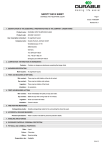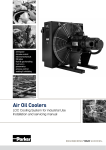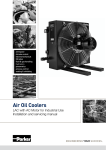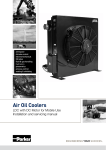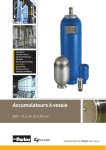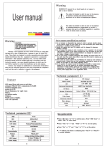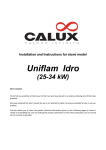Download GB - Appendix CE User Manual GB Accumulators
Transcript
12. ECOLOGICAL INFORMATION No indication. Catalogue HY10-4021-M1/EU GB - Appendix 13. DISPOSAL CONSIDERATIONS MATERIAL SAFETY DATA SHEET according 1907/2006/CE, Article 31 Product: Gas Loaded Accumulator Before any disposal, gas into the accumulators shall be totally released. Refer to the Instructions brochure or contact PARKER OLAERIndustries for this operation. 14. TRANSPORT INFORMATION 01.PRODUCT AND COMPANY IDENTIFICATION Proper shipping name: Articles, pressurized, pneumatic,containing non-flammable gas. UN Nr: 3164 Class / Div. 2.2 Subsidiary risk: None Hazard label: 2.2 (non-flammable, non-toxic gas) RID/ADR: Non subjected (special disposition nb.594) IATA: Packing group; -- (Strong outer packaging) IATA: Packing instruction: 208 IATA: Max. quantity per package: No limit IMDG: Packing group; IH IMDG: Packing instruction Appendix l IMDG: Fastening According to Category A 1. Product identification PARKER OLAERgas loaded accumulators are designed in accordance to the European Pressure Directive PED/97/23/EC or national regulations / calculation codes (ASME, DNV, ABS,…). Per definition of EN 14359:2006 standard a gas loaded accumulator is a hydraulic accumulator with separator between liquid and gas. The separator can be a bladder, a diaphragm or a piston. During transport and storage, PARKER OLAERaccumulators are: - filled with a gas pre-charge storage (between 2 and 5 bar maximum) - or filled with a gas pre-charge above gas pre-charge storage 15. REGULATORY INFORMATION Not included in 67/548/EC (not classified as dangerous substance). S9 Keep container in well ventilated place. S23 Do not breath the gas. 2. Identification of the company Parker Hannifin Manufacturing France SAS Etablissement de Colombes 16 rue de Seine 92700 COLOMBES - France www.parker.com/acde 02. HAZARDS IDENTIFICATION Main hazards: Gas under pressure 16. OTHER INFORMATION Conformity to PED 97/23/EC All national/local regulations observed if applicable Specific information regarding hazards for human being and environment: R22: There is no fragmentation danger related to the accumulator in transport or storage condition, Nitrogen may cause asphyxiation in high concentration, which could be nevertheless only possible in a non-ventilated space by high accumulation of Nitrogen (it could only be imaginable in case of intentional boring of a high quantity of accumulators). 03. COMPOSITION / INFORMATION ON INGREDIENTS N° CAS 07727-37-9 Other: Components/Impurities Catalogue HY10-4021-M1/EU GB 04. FIRST AID MEASURES Substance/ Preparation Nitrogen Contains no other components or Impurities which will influence the classification of the product CE User Manual Accumulators 4.1. General indication See. 4.2. Breathing protection: only in case of fire 4.2. Inhalation Nitrogen in high concentration may cause asphyxiation. Symptoms may include loss of mobility/ consciousness. Victim may not be aware of asphyxiation. Remove victim to uncontaminated area.Keep victim warm and rested. Call a Doctor. Apply artificial respiration if breathing stopped. 09. PHYSICAL AND CHEMICAL PROPERTIES 4.3 Skin contact No indication 4.4. Ingestion No indication 4.5. Indications for the Doctor No indication 05. FIRE FIGHTING MEASURES The following indications are not relative to the pressure vessel but only to Nitrogen 9.1. Appearance • Physical phase: gas • Colour; without • Odour: no odour warning properties 9.2. Physical and chemical properties • Molecular weight: 28 g • Melting point: -2l0°C • Boiling point: -l96°C • Relative density (gas): 0.97 (air =l) 5.1. Suitable extinguishing media 10. STABILITY AND REACTIVITY As neither the pressure vessel nor Nitrogen are flammable, all known extinguishing means can be used. 10.1. Conditions to avoid 5.2. Specific hazardous due to combustion products In general, gas-loaded accumulators shall not be subject to heavy temperature loads. 10.2. Substances to avoid Neither the pressure vessel, nor Nitrogen are flammable and generate combustion products. Because of potential gas formation due to the presence of rubber parts (seals, bladders, etc.) see 5.4. Avoid accumulator exposure to heavy corrosive media. 5.3. Special protective equipment for fire fighters 10.3. Hazardous decomposition products In confined space, use self-contained breathing apparatus Not known (see l1) 5.4. Specific indications 10.4. Other indications Move away from the container and cool with water from a protected position. As the rubber parts are degraded during fire, the gas is released and no burst of the pressure vessel is expected. Because of the possible combustion products generation, arrange a security area protected from wind. No other indications. 06. ACCIDENTAL RELEASE MEASURES N.A. because the pressure vessel is tight. 07. HANDLING AND STORAGE Gas-loaded accumulators shall be stored in a clean and dry area by room temperature in non-corrosive atmosphere. Accumulators shall be kept away from corrosive media or media which degrade painting. 08. EXPOSURE CONTROLS / PERSONNAL PROTECTION 11. TOXICOLOGICAL INFORMATION No indication for normal conditions. In case of fire, combustion products inflame mucosa, more particularly those of respiratory tracts and can conduct, if inhaled in high quantity, to lungs oedema.


